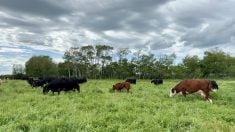In my last column, I wrote about some of the challenges facing producers who background cattle, both from a marketing and production perspective. Concerning marketing, emphasis was placed on differences between custom and owner-operated businesses. From a production perspective, both knowledge of cost of production and identifying goals of the nutrition program were stressed. Concerning the latter, emphasis was placed on identifying specific rates of gain for groups of cattle based on initial body weight and genetic background. Scenarios discussed included growing lightweight calves at relatively low rates of gain and backgrounding medium- and larger-framed calves at moderate to higher rates of gain. With this column, I want to examine these three scenarios in more detail and look at how we can use byproduct feeds in these programs.
Let’s start with backgrounding lightweight calves for grass. Typically, these are late-born calves weaned at 300 to 500 pounds. The goal is to slowly grow these calves over the winter for turnout on spring pasture. The key word is “slowly”! Average daily gains (ADG) of 1.25 to 1.75 pounds are often targeted.
This relatively slow rate of growth achieves two important objectives. First, it promotes frame and muscle growth while minimizing fat deposition which, from a nutrition management perspective, is one of the primary goals of a backgrounding program. Second, restricting growth over the winter promotes compensatory gain the following spring when the calves hit pasture. Compensatory gain is defined as a higher-than-expected rate of gain after a period of feed restriction. Like hybrid vigour from crossbreeding programs, compensatory gain is one of those management practices that make you think you won the lottery, as it generates extra weight gain without any further inputs or costs.
Read Also

The Canadian Cattle Association’s international advocacy efforts
Global ag policies affect Canadian food policy, so the Canadian Cattle Association participates in international and domestic forums
The opposite occurs if one backgrounds these calves over the winter at too high a rate of gain. This practice promotes fat deposition and results in “fleshy” calves going to grass. These animals can be discounted at the auction market, as they tend to go backwards for the first month or so of grazing.
The key to achieving these relatively low rates of gain is to target the appropriate dietary energy content. By design, these rations are high in fibre and relatively low in energy. The net energy of gain (NEg) value is typically in the range of 0.36 to 0.40 mega calories per pound of dry matter (Mcal/lb DM).
While cereal silage can serve as the base forage source, it is often necessary to dilute the ration with poorer-quality forages such as grass hay, cereal straw, oat hulls or baled corn stover. Similarly, feed grains such as corn and barley are often too high in energy for these rations. To get around this issue, many producers rely on locally sourced byproduct feeds as moderate sources of energy. Examples include various screening products (i.e. wheat, canola or pulse screenings), wheat or corn cracks, oat thins, as well as byproducts from the ethanol industry (i.e. wheat or corn DDGS). Protein content of these diets typically ranges from 12 to 14 per cent, with higher values for the lighter calves growing at the upper end of the range given above. Byproducts such as DDGS and pulse screenings (i.e. pea, lentils) are particularly useful as they serve as both energy and protein sources for these calves.
Backgrounding programs for heavier calves are based on the genetic background and weight of the animals being fed, which in turn dictates the targeted ADG and duration of the program. As opposed to the lighter calves discussed above, these heavier calves are usually destined to go directly to a finishing feedlot once the backgrounding program is complete. To illustrate, consider a pen of crossbred steers averaging 600 pounds each that are to be sold to a finishing feedlot at 900 pounds. Simple math tells us the program needs to target 300 pounds of gain per head. If these calves have a high proportion of “British” breeding in their background, daily gains of two to 2.5 pounds are typical. Duration of the program would range from 120 to 150 days. Pushing these medium-framed calves much harder will result in fleshy animals as noted above.
On the other hand, if we are dealing with calves that have a high proportion of exotic breeding, daily gains of 2.5 to three pounds are common. This is because these larger-framed calves have a higher genetic propensity for muscle growth and tend to fatten at heavier weights than their more medium-framed counterparts do.
The primary difference in rations for these two groups will be in dietary energy content. The medium-framed steers gaining two pounds per day would require a ration with an approximate dietary energy density of 0.41 Mcal of NEg per lb. DM. In contrast, the larger-framed animals at 2.75 pounds per day would require a dietary NEg value close to 0.5 Mcal per lb. of DM. Crude protein requirements would also be higher due to the higher rate of muscle deposition. As with the lightweight calves above, ingredients such as cereal silages and grains and various byproduct feeds can be used to formulate diets to desired energy and protein specifications.
In my next column, I will continue the discussion by looking at the opportunities and challenges of byproduct feeds.

















